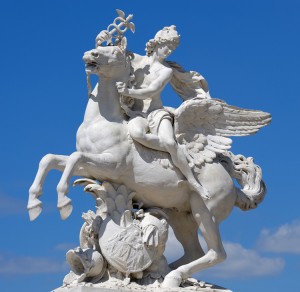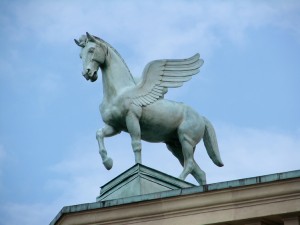Mythic Monday: Winged Pegasus
September 25, 2017
Look, up in the sky! It’s a bird! It’s a plane! It’s Superhorse! If you have ever stargazed in the Northern Hemisphere, you might have noticed Pegasus, a constellation resembling part of a horse. As commonly drawn, the constellation—named for Pegasus, the immortal winged horse of Greek mythology—appears to be galloping upside down across the heavens. Pegasus was among dozens of constellations cataloged by the ancient Greek mathematician Ptolemy about A.D. 150 in his great work Mathematike Syntaxis. Here on Earth, Pegasus the flying horse is one of the more interesting figures of mythological lore.
The Pegasus of mythology was the offspring of the Gorgon Medusa, a monstrous woman with snakes for hair, and Poseidon, the Greek god of the sea and earthquakes—and horses. The Gorgons were three sisters in Greek mythology whose ugliness could turn a viewer to stone. Pegasus was born when Perseus, a hero in Greek mythology, slew the pregnant Medusa by cutting off her head. Pegasus sprang fully grown from Medusa’s head—or from her neck or her blood or the soil fertilized by her blood, depending on the account. Pegasus was born along with a brother, Chrysaor, sometimes described as a giant and bearing a golden sword. Pegasus had a half-brother, Arion, who also was a magical horse and a son of Poseidon.

Mercury (a.k.a Hermes) rides Pegasus in the Jardin des Tuilieries Paris, France. Credit: © Zoran Karapancev, Shutterstock
The Greek legendary hero Bellerophon tamed Pegasus with help from the goddess Athena. One story tells that a prophet advised Bellerophon to sleep on Athena’s altar. There, Bellerophon dreamed that Athena gave him a golden bridle and ordered him to make a sacrifice to Poseidon. When he awoke, Bellerophon found a bridle on the altar. He sacrificed a bull to Poseidon and discovered Pegasus at a spring, waiting to be bridled.
Bellerophon and Pegasus had many adventures together. In one, the Lycian King Iobates sent Bellerophon to kill the Chimera, a fire-breathing monster that was part lion, part goat, and part serpent. Pegasus and Bellerophon flew over the Chimera, and Bellerophon slaughtered the monster with arrows. Pegasus also helped Bellerophon defeat the Amazons, a tribe of warrior women, and another tribe called the Solymoi. Bellerophon, a mortal human being, later tried to ride Pegasus up Mount Olympus, the home of the gods. Zeus, the ruler of the gods, became angry and sent a gadfly to sting Pegasus. The horse bucked, throwing Bellerophon down to Earth and crippling him. Pegasus then lived on Olympus, where he served Zeus by carrying the god’s thunderbolts.
Pegasus’s name may have come from the Greek word pêgê, meaning spring, and it is said that he created springs by striking the ground with a hoof. One of these springs, the Hippocrene spring on Mount Helicon, is associated with poetic inspiration. Some sources say that Zeus eventually turned Pegasus into the constellation that bears his name. If you would like to see the celestial superhorse for yourself, the constellation is best viewed in the northern sky from September through November.



